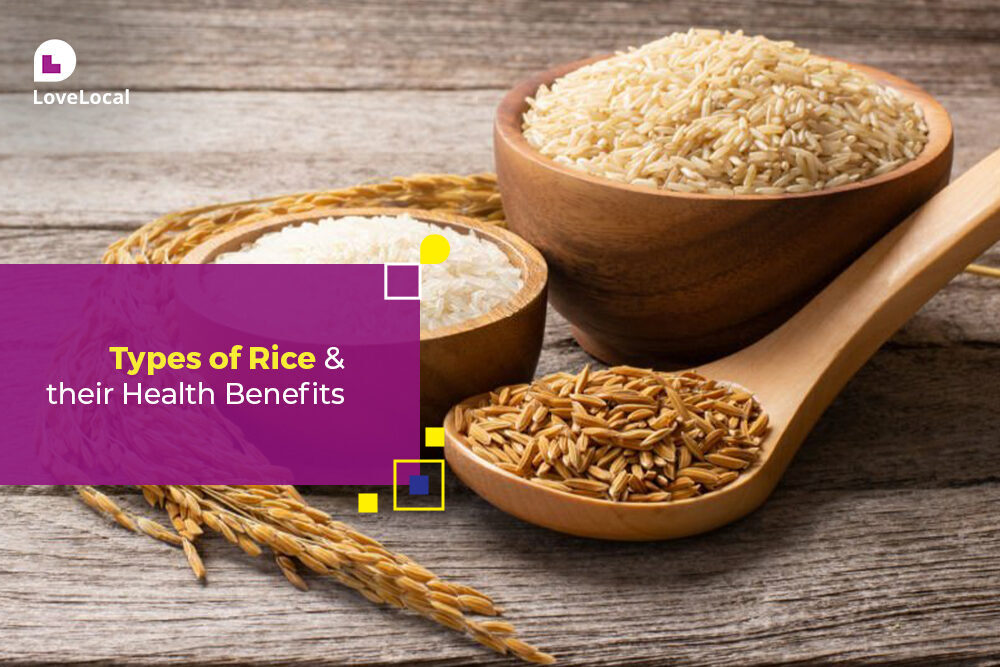Rice, a globally cherished grain, transcends its status as a mere dietary staple. Diverse in its varieties, each type of rice offers a unique combination of flavors, textures, and, notably, a myriad of health benefits. Let’s explore the different types of rice and the abundant wellness they bring to the table.
Understanding the Basics:
- Long-Grain Rice: Long-grain categories of rice, such as Basmati and Jasmine, is known for its elongated grains and fluffy texture when cooked. Basmati, with its aromatic fragrance, is a popular choice in Indian and Middle Eastern cuisines, while Jasmine rice adds a delicate aroma to Asian dishes.
- Short-Grain Rice: Short-grain rice, like Arborio and Calrose, tends to be stickier and chewier when cooked. These types of rice are favored in Italian dishes, especially for creamy risottos, while Calrose is a staple in Japanese cuisine, often used for sushi.
- Medium-Grain Rice: Medium-grain rice, such as Valencia and Bomba, falls between the long and short categories of rice in terms of size and stickiness. Bomba rice, known for its ability to absorb flavors well, is a key ingredient in traditional Spanish paella.
Nutritional Value of Rice
Before we deep dive into the various types of rice and its health benefits let’s explore the nutritional value of rice, based on 1 cup of cooked, unenriched white rice:
- Calories: Approximately 205 kcal
- Carbohydrates: Around 45 grams
- Protein: About 4.3 grams
- Fiber: Approximately 0.6 grams
- Fat: About 0.4 grams
Different varieties of Rice
Unlocking the nutritional goodness that different varieties of rice bring to the table.
1. Basmati Rice: Fragrance and Elegance
Basmati rice varieties originate from the Indian subcontinent, it is renowned for its distinct aroma and long, slender grains.
High in amylose, it has a low to medium glycemic index, making it a favorable choice for those aiming to manage blood sugar levels.
Basmati rice varieties are rich in fiber aiding digestion and promote a sense of fullness.
2. Brown Rice: Wholesome Nutrients
Brown rice, with its bran and germ intact, is a nutritional powerhouse compared to its white counterpart.
Brown rice nutrition content is packed with essential nutrients like magnesium, phosphorus, and selenium, brown rice supports bone health and has antioxidant properties.
Its high fibre content facilitates blood sugar regulation and helps with digestion.
3. Jasmine Rice: Aromatic Delight
Hailing from Thailand, these types of rice are celebrated for their fragrant aroma and slightly sticky texture.
While lower in fiber compared to brown rice, it still offers a good source of energy and contains essential vitamins and minerals.
The pleasant fragrance of these types of rice can elevate the dining experience, making it a popular choice in various cuisines.
4. Arborio Rice: Creamy Comfort in Risotto
Arborio rice, the star of creamy Italian risottos, has a high starch content that releases during cooking, creating a velvety texture.
Rich in carbohydrates, it provides a quick energy boost, making it a favored choice for athletes and those needing an energy pick-me-up.
5. Red Rice: Antioxidant Powerhouse
Red rice, with its distinctive hue, owes its color to anthocyanins, potent antioxidants associated with various health benefits.
These types of rice are a good source of iron and zinc, red rice supports immune function and helps maintain healthy skin.
Its nutty flavor and chewy texture make it a delightful addition to salads, stir-fries, and pilafs.
The Nutritional Spectrum of Different Types of Rice:
Different types of rice offer a variety of nutrients, explore all the nutrients they bring on the table:
- Brown Rice: Brown rice is a whole grain that retains its bran and germ layers, making it a nutritional powerhouse. Brown rice’s nutrition content is rich in fiber, vitamins, and minerals, it offers a nutty flavor and chewy texture. Its high fibre content facilitates better digestion and blood sugar regulation.
- Calories: 216
- Carbohydrates: 45 grams
- Protein: 5 grams
- Fiber: 3.5 grams
- Fat: 1.6 grams
· Vitamins and minerals: Brown rice is a whole grain, retaining the bran and germ layers. The following nutrients are abundant in it: thiamine, niacin, magnesium, phosphorus, selenium, and vitamin B6.
2. White Rice (1 cup, cooked):
- Calories: 205
- Carbohydrates: 45 grams
- Protein: 4.3 grams
- Fiber: 0.6 grams
- Fat: 0.4 grams
- Vitamins and minerals: While white rice is lower in nutrients compared to brown rice, it still contains small amounts of essential minerals like manganese, selenium, and magnesium.

- Wild Rice: Although not technically rice, wild rice is often included in the discussion due to its similar culinary uses. Packed with antioxidants, protein, and essential minerals, wild rice provides a unique taste and adds a visual appeal to dishes.
- Calories: 166
- Carbohydrates: 35 grams
- Protein: 6.5 grams
- Fiber: 3 grams
- Fat: 0.6 grams
- Vitamins and minerals: Wild rice is rich in B vitamins, particularly niacin, riboflavin, and B6. It also provides essential minerals such as phosphorus, zinc, and magnesium.
- Red Rice: Red rice gets its vibrant color from anthocyanins, powerful antioxidants linked to various health benefits. It offers a nutty flavor and a chewy texture, making it a wholesome choice for those seeking nutritional variety in their diet.
- Calories: 215
- Carbohydrates: 45 grams
- Protein: 5 grams
- Fiber: 4 grams
- Fat: 1.5 grams
- Vitamins and minerals: Red rice gets its color from anthocyanins, which also provide antioxidants. B vitamins, iron, and zinc are all abundant in it.

Health Benefits:
- Rich in Essential Nutrients: Different types of rice offer varying nutrient profiles, but most are good sources of energy, essential vitamins, and minerals crucial for overall well-being.
- Heart Health: Brown rice, in particular, is linked to heart health. Its high fiber content helps lower cholesterol levels, reducing the risk of heart disease.
- Digestive Health: The fiber in these types of rice aids in digestion and promotes a healthy gut. It can help prevent constipation and other digestive issues.
- Weight Management: Choosing whole grains like brown rice can contribute to weight management due to their fiber content, promoting a feeling of fullness and reducing overeating.
- Antioxidant Properties: The pigments that give different types of rice their distinct colors, such as the anthocyanins in red rice, possess antioxidant properties that help combat oxidative stress in the body.
Conclusion
In the diverse world of different forms of rice, each type brings not only unique flavors and textures but also a spectrum of health benefits. From the fragrant elegance of Basmati to the antioxidant power of red rice, incorporating various types of rice into your diet ensures a balance of nutrients and a delightful culinary experience. Unlock the goodness of all varieties of rice, and let your meals become a celebration of both taste and well-being. Shop at LoveLocal to support local retailers!



